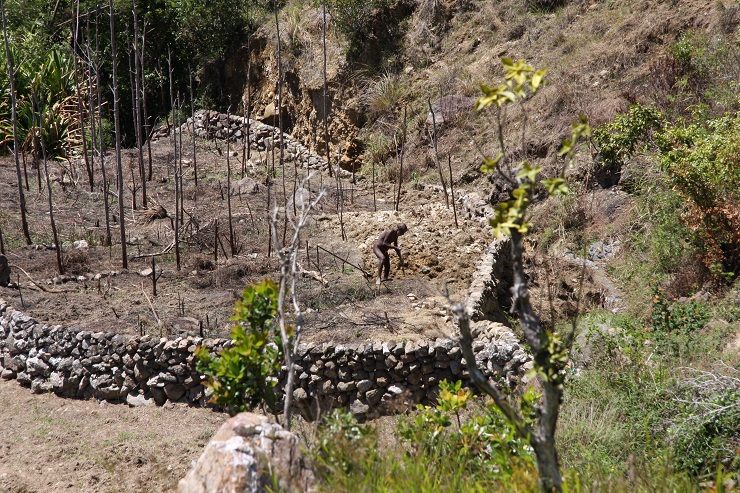According to the evolutionary paradigm garden agriculture (or horticulture) should precede field farming (or agriculture). Lewis Henry Morgan, one of the original founders of anthropology, was convinced of this. Gradually, however, it began to appear that model of this nature is inconsistent with any of the archaeological or ethnological data.
Garden cultivation, however, is still considered as being the best model of the agriculture during the Neolithic period. The technological processes are reconstructed on the basis of ethnographic examples that exhibit certain features typical of garden farming. It was primarily characterised by the smaller areas of the plots that were cultivated. The land was cultivated without the use of hoes or of ploughs. Usually irrigation of the land was not provided artificially, though, in some cases, fertilisation was carried out. Instead of vast single- crop fields, small plots were planted with several different kinds of crops and with shrubs and fruit trees. Either migratory cultivation was utilised, in the course of which after the cultivated plots had been exhausted they were abandoned and left to nature, or there were regularly fertilised fenced plots that were cultivated over a long period. Part of both of these techniques might comprise slash and burn agriculture, thereby representing one specific type of cultivation or one manner of preparing previously unused land.
 |
| In the Highlands of New Guinea agricultural crops are grown in gardens that have either stone or wooden fences to prevent the intrusion of hungry pigs. Remnants of the original tree vegetation also comprise a segment of the cultivated plots. Photo by Jan Rendek. |
In terms of the effort and the energy expended garden agriculture did not have to lag behind the more intensive farming techniques. Conversely, the cultivation of crops over large areas does not always have to be carried out with a rigorous and exhausting degree of intensity. The ideas that we have concerning Neolithic agriculture are the result of observing the garden agriculture in the Amazon basin and then, more recently, in New Guinea. Both these models vary in accordance with the local environmental conditions.
Garden farmers used the products of their farming primarily for the purpose of meeting their own subsistence needs. Although usually not all the foods were consumed and it was possible to create a stock and benefit from it, this did not actually happen. The reason for this was that the social mechanisms effectively prevented the disruption of the equity balance. Part of this social system included giving gifts and organising feasts.
The adoption of agriculture also caused, amongst other things, interference to the society and the culture of archaic humans. One of the fundamental correlates was the significant degree of sedentarisation and stabilisation of the social base. The communities grew larger while more and more people were sharing natural resources, which demanded a more complex and structured society. Kinship also continued to play a major role and by then had outgrown the basic level of one family and, based on a common ancestor - real or imaginary – it successfully aspired to integrate the members of several different families. That does not mean that we would not have been able to find clans of hunter-gatherers, but their existence actually began to manifest anew directly in regard the cultural realities of the agricultural society. Most property rights regarding the use of land for grazing, or for its water resources or for mining raw materials were associated with specific relational units. Authority could be held by community leaders, big men and/or a board composed of persons of a corresponding status. Their authority was limited, however, and it was dependant mainly on persuasive skills and acknowledged prestige.
Want to learn more?
- Bogaard, A. 2005. ‘Garden Agriculture’ and the Nature of Early Farming in Europe and the Near East. World Archaeology 37 (2):177-196.
- Boserup, E. 1965. The Conditions of Agricultural Growth. The Economics of Agrarian Change under Population Pressure. Chicago: Aldine.
- Parkinson, W. A. (ed). 2002. The Archaeology of Tribal Societies. Michigan: Ann Arbor.
- Sherratt, A. 1981. Plough and pastoralism: aspects of the secondary products revolution. In Pattern of the Past: Studies in honour of David Clarke, eds. I. Hodder, G. Isaac, and N. Hammond, 261-305. Cambridge: Cambridge University Press.
- Steensberg, A. 1980. New Guinea gardens. A study of husbandry with parallels in Prehistoric Europe. London: Academic Press.
- van der Veen, M. 2005. Gardens and Fields: The Intensity and Scale of Food Production. World Archaeology 37 (2):157-163.
 Archeologické 3D virtuální muzeum
Archeologické 3D virtuální muzeum

.jpg)